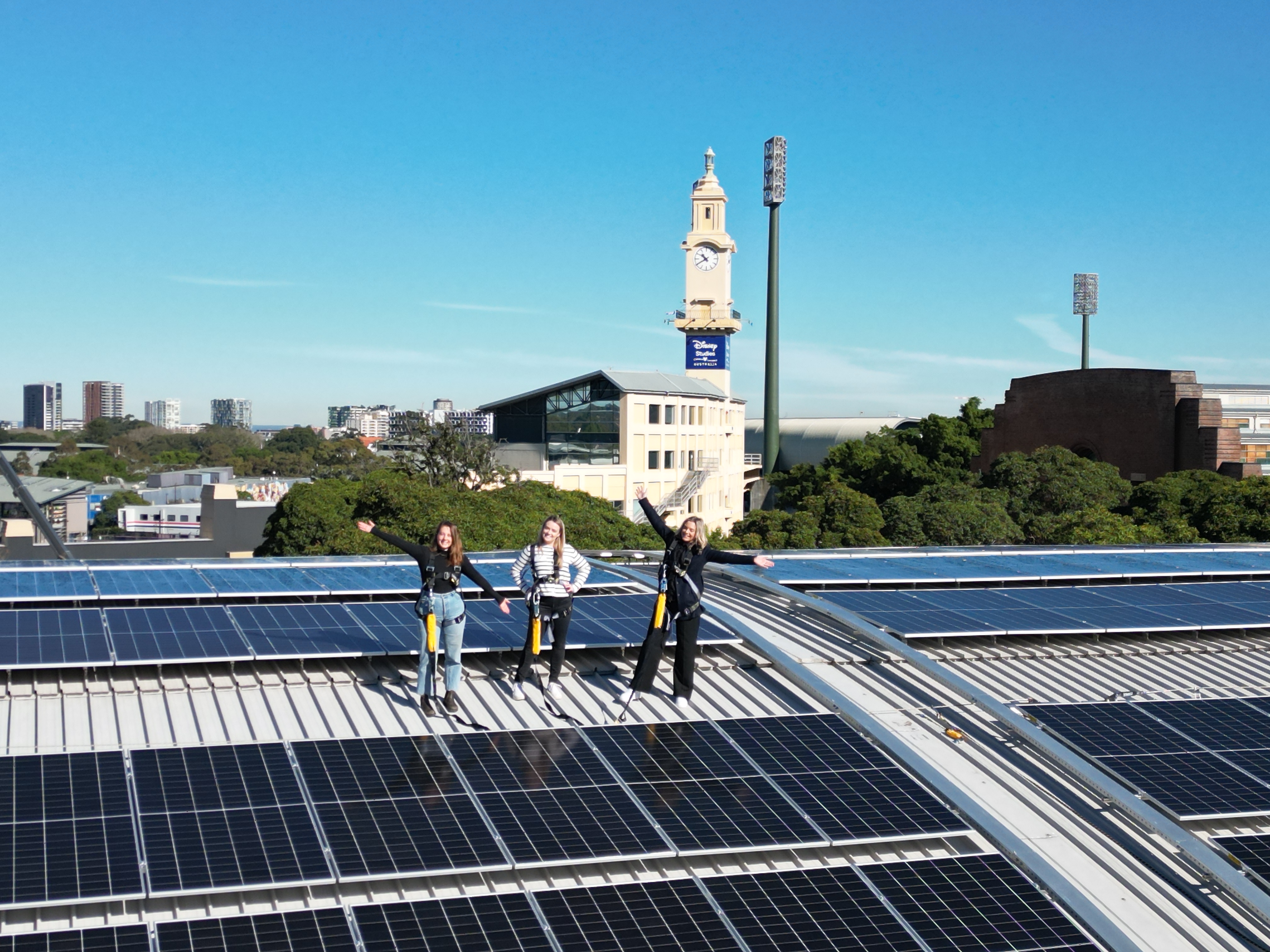Carnival Films and Universal International Studios Lead the Way with HVO Renewable Diesel Use on All Her Fault
The use of HVO100 as a power source on Peacock's production of All Her Fault marks a pivotal moment for sustainability in the Australian film industry

The highly anticipated Peacock suburban-thriller series All Her Fault is only midway through production, but already seeing big wins for sustainability in film and television production. The series is produced by Carnival Films, with Australian-based Matchbox Pictures providing production services, both of which are part of Universal International Studios, a division of Universal Studio Group.
As a part of the studio’s Sustainable Production Program, All Her Fault is working with UK sustainability consultants Picture Zero, to reduce its environmental impact through hybrid generators, grid power, mobile battery technology, and hybrid and electric vehicles.
The production is also using HVO100 (100% HVO fuel and 0% diesel) to power operations on location. The use of HVO on productions has been tried and tested for years in the UK and USA, but All Her Fault is the first Australian production trailblazing its use locally.
Why use HVO on Australian film and television productions?
Hydrotreated Vegetable Oil, commonly known as HVO, is a renewable drop-in replacement for diesel produced by hydrotreating oils such as rapeseed oil or used cooking oil. While electrification of power and transport are the priorities for decarbonising production, this transition toward electrification will take time. In the meantime, using HVO as a substitute for diesel provides an effective interim solution to power existing equipment while significantly reducing emissions.
The Universal Studio Group has been using HVO on its productions around the world for many years, and in recent years utilising it widely in generators and vehicles, including on Carnival Films productions. As Picture Zero sustainability consultant Alex Cheesman explains: “It is now very common on UK productions. It is also widely available throughout Europe and in production hubs in the USA. It's rapidly becoming the 'new normal' for powering generators in other parts of the world, and we are so excited to help that happen in Australia too.”

Busting 6 myths about HVO
MYTH #1 – HVO is the same as biodiesel
FACT: Biodiesel and HVO (also known as renewable diesel) are both fuels made using vegetable oils, but have different production processes and therefore differ in how they can be used. Unlike biodiesel, HVO is chemically similar to fossil diesel and has been widely approved as a direct substitute for conventional diesel fuel in engines such as generators, cars and industrial machinery.
MYTH #2 - Renewable diesel/HVO doesn’t reduce emissions
FACT: Using HVO instead of diesel eliminates up to 90% of life cycle emissions. According to Alex, “generally, the emissions reductions are measured by batch, delivered by the supplier/distributor, and these generally range between 80-90% reductions in CO2e for waste-derived HVO across the whole life cycle of the product.” Not to mention that HVO also produces fewer harmful gases such as particulate matter (PM), nitrogen oxides (NOx) and carbon monoxide (CO), contributing to cleaner air.
MYTH #3 - All HVO is derived from virgin palm oil
FACT: HVO is primarily derived from leftover vegetable oils, so you are actually using a product destined for the bin! Some HVO fuel uses palm oil, but it’s often repurposed or considered waste. It’s important to consult with your supplier to determine the origin of all oils. Neste (the supplier on All Her Fault) doesn't use virgin palm oil, and its HVO is entirely waste-derived. You can read more about it here.


MYTH #4 - HVO isn’t cost effective
FACT: When combined with a hybrid generator, on a shoot longer than eight weeks, HVO becomes more financially viable as the amount needed with a hybrid system is 60-70% less than a traditional generator. Also, because HVO is oxygen-free, it has a longer shelf life compared to conventional biodiesel, which makes it better for storage and long-term use.
MYTH #5 - HVO is unreliable in the cold
FACT: HVO performs well in extremely cold weather because it has a high energy content and low pour point, meaning it doesn't solidify like other renewable diesels derived from animal fats - important on All Her Fault, which shot through a Melbourne winter!
MYTH #6 - HVO will ruin your tank / engine
FACT: HVO is chemically similar to diesel and is considered a ‘drop in’ fuel, meaning it can be used in diesel engines and generators with no modifications and can even be mixed with diesel. It also has a high cetane number (fancy talk for ignition), which can lead to better engine performance and smoother operation. Many major manufacturers of generators and vehicles are now making explicit statements that their equipment is compatible for use with HVO with no changes to manufacturer warranty.

How Carnival Films and Matchbox Pictures are using HVO100 on All Her Fault
With sustainability at the forefront, All Her Fault has looked to minimise its environmental footprint and lower energy use from the outset. Powering a 15-truck unit base to support 140-150 crew, plus cast, requires considerable energy. To do so in a low emission capacity, Unit Manager Andy Pappas decided on a 2x hybrid setup of a 90kWh battery paired with an 80KvA traditional generator. Hybrid setups are increasingly becoming the go-to power source on productions due to their many benefits (check out our explainer article here).
This production went one step further and chose HVO100 for its generator fuel - the first time a production has done so in Australia. Alex says: “Fossil fuel consumption, whether from generators or from vehicles, is frequently one of the biggest contributors to a production's carbon footprint, so a product like HVO can make a huge difference.” It should be noted that HVO comes in various blend percentages, which can be easily identified by the number after ‘HVO’. So HVO100 has 100% HVO fuel and 0% diesel.


When it comes to pushing the envelope with sustainability in film and television production, there are bound to be some unique considerations:
Limited availability means getting creative
HVO100 is not currently produced in Australia and importing small quantities independently is unfeasible. The solution? Piggybacking on a much bigger delivery from Singapore-based company, Neste who have recently opened an office in Melbourne. In an ideal world, all resources would be local. However, Picture Zero analysed the ‘Well to Tank’ emissions, which account for the emissions generated during the production, transportation, transformation and distribution of the fuel before combustion. The results showed that HVO has significantly lower well-to-tank emissions compared to diesel, in addition to its lower emissions during combustion. This is because most of Australia’s fossil diesel is imported from Japan or Korea.
It will soon be the new normal
Because HVO100 is not commonly used in Australia, it is not widely known that it can directly replace diesel. However, Andy found that Green Power Solutions were more than happy to trial HVO100, given its prevalence and wide usage internationally. Sweden, Finland, Germany, the Netherlands, the UK and France have all embraced HVO in their transportation, industrial and energy sectors to support their strong environmental policies and reduce greenhouse gas emissions and HVO is even beginning to become available at fuel stations in Europe!
The emissions, cost and workplace benefits are significant
HVO100 is currently more expensive ($6/litre vs $2/litre for diesel). However, when using the hybrid system, much less fuel is needed over an entire shoot period. A generator running for two or three hours a day means fuel consumption is down to 30% or 40% compared with a traditional generator running for a full day on diesel. For a five-month shoot, the estimated cost is the same, if not cheaper. The biggest benefit, however, is the carbon emissions savings. HVO100 is reducing the emissions on All Her Fault by up to 90%, drastically lowering their overall carbon footprint. When comparing Scope 1 emissions factors for Australia, diesel emits around 234 times the amount of HVO (HVO at 0.01kgCO2e/litre in comparison with diesel at 2.71kgCO2e/litre). In addition, HVO supports a healthy workplace for cast and crew by providing a fume-free and clean working environment.


All Her Fault setting a new standard for sustainability in film and television
The production of Peacock’s All Her Fault marks a pivotal moment for sustainability in the Australian film industry. By using HVO100 as a power source, Carnival Films, Matchbox Pictures and Universal International Studios are paving the way for other Australian productions to follow suit.
And this couldn’t come at a better time for the industry. As an interim measure, HVO not only reduces emissions, but also works extremely well with hybrid power setups without sacrificing performance or requiring major changes to existing equipment! A high-value thriller, with a low carbon footprint







